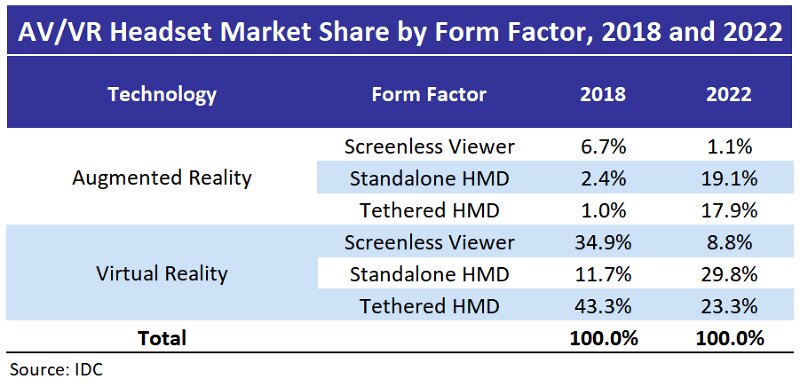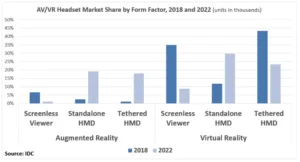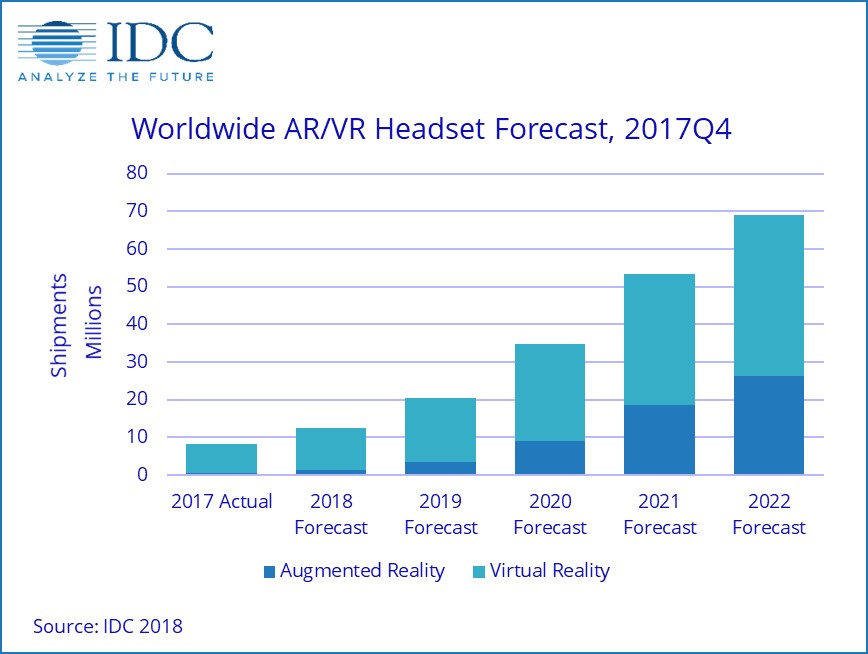Worldwide shipments for AR and VR headsets will grow to 68.9 million units in 2022 with a five-year CAGR of 52.5%, according to the latest forecast from the IDC.
Despite the weakness the market experienced in 2017, IDC anticipates a return to growth in 2018 with total combined AR/VR volumes reaching 12.4 million units, marking a year-on-year increase of 48.5% as new vendors, new use cases, and new business models emerge.
The worldwide AR/VR headset market retreated in 2017, primarily due to a decline in shipments of screenless VR viewers. Previous champions of this form factor stopped bundling these headsets with smartphones and consumers have shown little interest in purchasing such headsets separately. While the screenless VR category is waning, Lenovo’s successful fourth-quarter launch of the Jedi Challenges Mirage headset—a screenless viewer for AR—showed the form factor may still have legs if paired with the right content. Other new product launches during the quarter included the first Windows Mixed Reality VR tethered headsets with entries from Acer, ASUS, Dell, Fujitsu, HP, Lenovo and Samsung. IDC’s Jitesh Ubrani said:
“There has been a maturation of content and delivery as top-tier content providers enter the AR and VR space. Meanwhile, on the hardware side, numerous vendors are experimenting with new financing options and different revenue models to make the headsets, along with the accompanying hardware and software, more accessible to consumers and enterprises alike”.

Looking ahead, IDC also expects the VR headset market to rebound in 2018 as new devices such as Facebook’s Oculus Go, HTC’s Vive Pro and Lenovo’s Mirage Solo ship into the market with new capabilities and new price points. Meanwhile, with the exception of screenless viewers, AR headsets are likely to remain largely commercially focused until later in the forecast due to the technology’s high cost and complexity. IDC’s Tom Mainelli commented:
“While there’s no doubt that VR suffered some setbacks in 2017, companies such as Google and Facebook continue to push hard toward making the technology more consumer friendly. Meanwhile, Lenovo’s success with its first consumer-focused AR product shows that consumers are beginning to understand what augmented reality is and the experiences it can provide. This bodes well for the category long-term”.
Augmented Reality head-mounted displays will see market-beating growth over the next five years as standalone and tethered devices grow to account for more than 97% of the market by 2022. IDC expects AR screenless viewers, the overall market leader in 2017, to peak in 2019 as standalone and tethered products become more widely available at lower price points. The rise of screenless viewers geared toward consumers tilted shipment volumes away from commercial viewers in 2017 and that’s likely to continue in 2018. By 2019, the segment will shift back toward more commercial shipments.
Virtual Reality head-mounted displays will see a shift in product mix. Screenless viewers, once the overall leader, will see share erode quickly over time. Meanwhile, standalone and tethered devices – in the minority in 2017 – will comprise 85.7% of total shipments by 2022. Consumers will account for a majority of headset shipments throughout the forecast but commercial users will slowly occupy a larger share, growing to nearly equal status in 2022.


